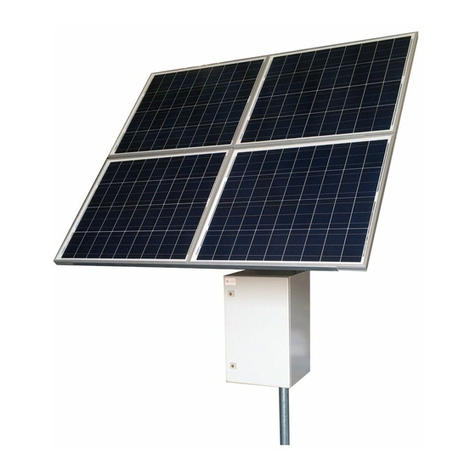5
seal all holes and feedthrus with silicon.
STEP 14: Make sure lid gasket is clean and free from any particles,
then carefully close the cover, making sure that wires are clear of the
seam and hinge area. Use the special key to close the two cover locks.
TECH CORNER
Additional Information you may find useful
1. CONTROLLER: The controller turns off power to the load at 22V and
reconnects when the battery reaches 24V. This protects battery from
overdischarge and increases battery life and performance.
2. CAPACITY: The RemotePro® RPST2424 is rated at 30W continuous
power output with 6 hours of peak sun per day. Reserve battery capaci-
ty at 15W load is 33 hours and 17hours at 30W
3. VENTING: The enclosure is vented thru the wire feedthrus and vari-
ous hole plugs in the bottom of the enclosure. Don’t make these airtight.
4. BATTERY MAINTENANCE: The batteries used in the Remote Pro
systems don’t require any maintenance. They should last up to 5 years
in normal use. Note: Never store batteries for any length of time in a
discharged state or it will kill the battery.
5. SOLAR PANEL TILT: There is a solar panel tilt calculator at the
Tycon® website tyconsystems.com/index.php/resources/tools. We rec-
ommend using a fixed tilt and setting to optimize for winter sun. The
panel should face South if you are in the Northern Hemisphere and face
North if you are in the Southern Hemisphere. Some typical winter tilt
angles are as follows:
6. BATTERY OVERDISCHARGE: We highly recommend hooking all
equipment loads to the controller voltage output. This output will discon-
nect the load if the battery voltage drops below 22V and this will protect
the battery from over-discharge. If batteries get completely discharged
because the equipment was connected directly to the battery, you will
reduce the battery life and you will most likely need to supercharge
them with a good quality 10A automotive battery charger. Once they
are back to a normal operating range, the integrated charge controller
will maintain the charge.
7. WIND TURBINE: A wind turbine can be added to this system at any
time. Wind Turbines are good sources of power, often in times when
the sun isn’t shining, like on stormy days. We like to think of a wind tur-
bine as uptime insurance. Tycon Systems® offers small wind turbines
perfectly suited to augment the RemotePro® systems. The TPW-400-24
is a 400W 24V wind turbine. The TPW-200-24 is a 200W 24V wind tur-
bine. To add a wind turbine, it mounts to the top of a 2” diameter pole.
You will need to mount the controller inside the enclosure and connect


























